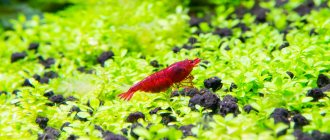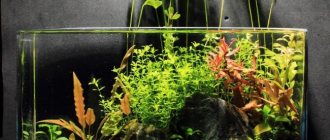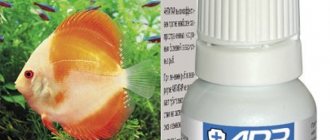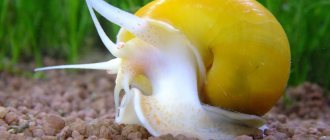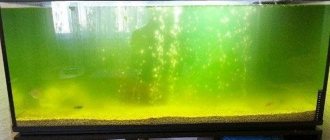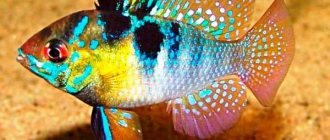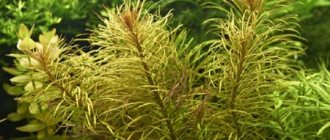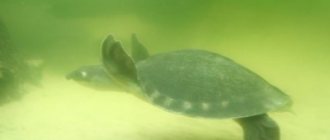Those who dream of the first aquarium in their life usually imagine a 20-25 liter tank. Beginners think that this is the optimal size in which they can easily create their own underwater world. There are those who, for some reason, really can’t afford to have a large aquarium at home. Sometimes unpretentious aquarium fish are vitally needed. And there are also aquarists whose goal is to maintain a nano aquarium with small fish. All this is quite real. In pet stores you can find aquariums for beginners, unpretentious fish for a small aquarium, and even special devices for creating a truly correct biotope.
Small home aquarium: rules
Even small fish require attention and careful treatment. It is more difficult to create good conditions in a 10 liter aquarium than in a 100 liter tank. Useful information for a beginner - basic requirements for a home aquarium:
- Pure water. There should be no objects in the water that release harmful substances into the water.
- Compliance with parameters. Even the smallest aquarium fish cannot live in very alkaline or overly acidic environments, high in chlorine or nitrates. Hardness, acidity - all this will have to be checked regularly.
- Compliance with fish requirements. If the fish needs soil at the bottom, it should be there. If the fish does not need aeration, then the beginner is lucky and there is no need to install a compressor.
- At least minimal care. Like any animal, fish for a small aquarium will still require attention from you: for example, regular water changes.
- It is especially difficult to maintain temperature in small aquariums. You will have to carefully monitor the water temperature.
- It is equally important to ensure that there is no overcrowding in the nano aquarium. Compatibility is the most important parameter when choosing.
Barbs
Barbs are aquarium fish (the names reflect either anatomical features - the length of the mustache, color, or habitat), which belong to the Cyprinidae family. About 15 species differ in color and size.
Too active barbs can stress less active species. In addition, males do not mind fighting or biting something from an unwary neighbor. The best options for sharing would be: bots, labeos, clowns, swordtails, platies, gurs. You can fill an aquarium with only barbs of several species.
Fish require careful care. Their contents must include the following:
- aeration;
- water temperature +21…+23 оС;
- creating a flow using a pump;
- presence of dense vegetation;
- regular water purification using special filters;
- change water - at least once a week.
The species has an excellent appetite, so the fish are prone to obesity. Everything edible that gets into the aquarium is consumed - dry and live food, plant food.
Small fish for the aquarium: top 10 popular species
- Sumatran barbs. Live, active fish that need strong currents. Therefore, when setting up an aquarium, it is important not to forget about the filter that this current will create. Good conditions - an aquarium of 30 liters per flock. It would be better if the aquarium was larger. Barbs feel better in cool water; this is very difficult to organize in mini-aquariums.
- Catfish Corydoras (speckled). Small, unpretentious fish that live mainly on the bottom. They do not need additional air, since they have “gut respiration” and do not only breathe through their gills. Peaceful, calm and positive fish that will become good neighbors to other representatives in an aquarium with a volume of 30 liters or more.
- Platies are creatures that are quite tolerant of poor conditions. Unlike colored fish, guppies have a restrained color scheme and a somewhat combative disposition. They easily fit into aquariums from 30 liters, but they prefer larger tanks. If there is overpopulation, they can start a war. Often in small aquariums they coexist with small catfish.
- Lemon tetra. Grows up to 4 cm, loves a flock of its own kind. Undemanding to conditions and easy to care for and maintain. Bright, and with the right lighting it becomes irresistible.
- Gourami and lalius. They are labyrinthine, which means they have a special breathing system that allows them to do without aeration. For small aquariums this is very important, since it can be very difficult to place a compressor in 20-30 liters.
- Guppy. Perhaps the most popular fish, which is known not only to beginners, but also to people who are generally far from aquarium hobby. Male guppies are brightly colored, with lush fins. Females are larger, but less attractive. Guppies are peaceful and viviparous; under good conditions they can reproduce spontaneously. The optimal volume is at least 20 liters for 5-6 fish. They have an accommodating character, but in a close group they can become unattractive and often get sick.
Interesting fact: despite the fact that we tend to take guppies lightly, there are true connoisseurs of this species. They strive to have rare and unique breeds and spend considerable sums on this.
- Cardinal. Like guppies, male cardinals are brighter than females, but in principle, fish of both sexes look good in a small aquarium. They need a flock of their own kind - at least 12-15 pieces. Calm and cheerful fish that reproduce successfully given suitable conditions. The aquarium for such a flock should be from 40 liters.
- Iriaterina Werner. A fish up to 6 cm in size, with large beautiful fins. Requires an aquarium of 30 liters for 2-3 pieces. Very demanding on water parameters.
- Notobranchius Rachova. The males of these fish are incredibly bright orange-blue. For one family of 2 fish, a capacity of 20-25 liters is enough. But they are demanding on parameters and temperature (they prefer cool water).
Settlement rules
When filling the container, you need to correctly calculate the number of fish. For one individual measuring 6 cm, 3 to 5 liters of water are needed. Overpopulation will cause discomfort for the inhabitants of the aquarium. This is a very conditional calculation. For any declared volume of the product, you must pay 12-15% for accessories, gravel, and plants.
A factor such as habitat is also taken into account:
- bottom fish;
- those who prefer to swim at an intermediate level;
- those that float on the surface.
If the vital volume is filled correctly, the container will not seem empty, and the inhabitants will not interfere with each other’s peaceful living and reproduction.
It is not recommended to keep fish in a completely empty aquarium, especially a round one. Even a very hardy goldfish will experience constant fear in it due to the lens effect. A little vegetation, gravel at the bottom (sand will pollute the water), compact maintenance devices will not spoil the overall appearance of the aquarium.
Fish for nano aquariums
Nano aquariums include tanks of 4 liters, 5 liters and up to 10 liters. In themselves, such home aquariums are very convenient: they become a desktop decoration along with family photographs and stationery. But in order for the fish to live happily ever after, the microaquarium must be taken care of especially carefully.
- Cockerels. It is believed that this bright fish with lush fins and amazingly beautiful color can live in a glass of water. Of course, this is a misconception; one individual should have at least 4-5 liters, and optimally 7-10 liters. If you want the fish to be happy, a male betta needs a 30-liter aquarium and 2-3 females. Two males definitely won’t get along in a mini aquarium.
- Neon. One of the smallest fish for an aquarium. In theory, several individuals will be fine even in a volume of 10 liters. But neons can hardly be called unpretentious. They prefer to live in flocks of 10-15 pieces, and for such a number they need a tank of at least 40 liters. In addition, neons, like striped zebrafish, are demanding on water parameters. Neons rarely get along with other fish - they are defenseless.
- Danio. They are similar in size and behavior to neons, but do not need a large flock. Appearance – longitudinal dark stripes on a light background. There are also spotted and red ones. They have a wide temperature range (from 15 to 30 degrees), but like all living aquarium settlers, they do not tolerate sudden changes.
- Micro-assortment. Perhaps the most unpretentious aquarium fish for a small aquarium, they grow up to 2 cm. Only 1 liter of water is required per individual, so a mini-flock can be comfortably placed in a nano-aquarium. They look especially good in aquariums filled with living plants and mosses (aquascape), which is done by nano-aquarium professionals. But a beginner who wants to learn aquascaping can start with a small tank.
- Blue-eyed Norman. If you organize the right lighting, the fish will sparkle with amazing neon shades: this is how the eyes of small fish will glow. The size of each individual is 3-4 cm. Playful, active, they are successfully placed in aquariums of 15-20 liters.
- Tetradon dwarf. A rare fish so far, bred specifically for small containers. For a couple of fish, 10-15 liters is enough. But the tetradon is a rather aggressive fish that can start a war for territory, so if possible, it is better to find a larger container and equip it correctly.
- Tetra amanda. Several fish 2 cm long can live in a tiny aquarium, however, tetra is a schooling fish, so the best option is a 30-40 liter tank and a school of 6 pieces. They require good filtration: the water must be clean.
- Neoheterandria elegans. While a little-known breed, it has a bright brindle color and an unpretentious character. For a couple of fish measuring 2.5-3 cm, 10 liters of water is enough. Good fish for beginners, there is one drawback: they are still difficult to find on sale.
- Tetra elahis. Also a rare little one, up to 2 cm in size. It has a soft blue color with spots in the tail area. Prefers to be kept in a flock. For 3-4 individuals you need an aquarium of 20-30 liters, and a full-fledged comfortable flock of 6-8 fish will require an “apartment” of 30-40 liters.
- Formosa. Very easy to maintain, does not require any special conditions, and an aquarium is suitable from 12 liters. Outwardly it resembles neon, but is somewhat smaller in size.
More difficult in content
Among unpretentious aquarium inhabitants, there are species that are demanding on the quality and parameters of water: more attention and time for caring for the aquarium.
Lyalius
Conditionally peaceful owners of a labyrinthine respiratory organ. They require frequent aquarium maintenance and a large water space. Timely cleaning of the soil and changing water will ensure a comfortable existence for the lalius. They grow up to 8 cm and are colored with alternating bluish-green and orange stripes.
Gourami
It is acceptable to keep it in a spacious aquarium of 80 liters or more. Gourami require more care than their common hardy counterparts. Pets with different color variations are active. Popular gourami are marbled, pearl, rainbow and golden gourami. Aggression from males is possible.
Neons
You will need soft and slightly acidic water. Water changes should be carried out unnoticed. Neon fish do not need a large aquarium and are kept with peaceful species. They grow up to 5 cm in length. They live longer at low temperatures from 18 degrees in a flock of representatives of their species.
Ternetia
Active, kept in a flock. The body of the thorn reaches 5 cm and is compressed on the sides. Wide fins look unusual. Like other characins, they live in soft water.
Tetras
Friendly, kept in flocks of 8–10 individuals. In dim lighting the color becomes brighter. The combination of beauty and unpretentiousness makes tetras common among aquarists.
Cichlids
There are more than 2 thousand species in the cichlid family. Mostly predatory and territorial, they take care of their offspring. Cichlids are demanding. Take care of the compatibility of residents and maintaining the cleanliness of the reservoir. The least demanding ones are distinguished, for example, angelfish and black-striped cichlases.
Angelfish
Cichlids with a diamond-shaped body reaching 15 cm in length. They move smoothly and gracefully. Angelfish prefer live food with a high protein content. Temperature 22–26 degrees, bright lighting and clean water will be required.
Black-striped cichlazomas
Also called striped cichlazoma. Large, inhabit an aquarium of 100 liters or more. The striped color attracts attention. Caring for them includes periodic feeding, changing water and monitoring their condition. Aggressive during spawning.
Catfish
The appearance of catfish is recognizable; many people like their peaceful disposition. Unpretentious in food and maintenance, catfish demonstrate endurance and vitality. They take part in cleaning the aquarium from uneaten food and lower algae. Ideal neighbors for most fish. Large ancistrus and small corydoras catfish are common. Popular species: speckled, spotted and panda catfish.
Ancistrus
They grow up to 20 cm at home, so choose an aquarium with a volume of 200 liters. Ancistrus catfish are thermophilic, the optimal temperature ranges from 26–30 degrees.
Corridoras
A genus of catfish with a body length of up to 7 cm. They are kept in groups in soft water. During the day they hide in shelters. Activity hours are at night.
What kind of fish to get and how to combine them in small quantities
Aquarium 4-5 liters: it is better to leave without live fish, you can limit yourself to just a beautiful design.
Aquarium 10 liters:
- 1 cockerel;
- 3-4 cardinals
- 4-5 guppies or Endler’s guppies (these are natural individuals, they are even smaller than the ones we are used to, bred by breeders);
- 4-5 neons;
- 4-5 Norman blue-eyes;
- up to 10 microdigestions
It is better not to combine several species in such a tank: the schools will be too small, and the fish will not live happily.
Aquarium 20 liters:
- 1 male cockerel with 2-3 females;
- 12-15 guppies;
- up to 20 zebrafish or neons;
- 5-7 cardinals;
- 10-12 happy neons;
- up to 20 microrasbor.
Can be combined:
- 5 guppies and 5 zebrafish;
- 10 guppies and 2 speckled catfish;
- 7-8 neons and 2 speckled catfish.
30 liter aquarium:
- 4-5 barbs;
- 2-3 apistograms;
- 12-15 cardinals;
- 20-25 neons or zebrafish;
- 2-3 macropods;
- 2-3 Werner's iriaterina;
- 10 analysis
30-40 liters is considered ideal for a beginner. It is convenient to observe the behavior of fish, track diseases and organize feeding.
Terrible option
On sale you can find so-called closed aquariums. In our market, most often this is a closed round aquarium with a shrimp, but there are similar options with fish. It is assumed that the animal can exist independently in such a small volume, or it is possible to feed a couple of flakes of food. The argument is: “There are no food pellets in nature, the fish must get their nutrition from the environment.” Although in reality the fish lives in a small amount of water without other creatures.
In nature, fish live in a huge, well-developed ecosystem, where there is a huge amount of water that is regularly renewed. And food supplies in the natural environment are not limited to a few flakes once a day. In nature, fish have access to a variety of living plants, insects, larvae, worms, crustaceans and smaller fish.
In a closed small system with only a plant, the fish or shrimp will slowly starve and become sick due to the stress of being in such a small container. It is better not to buy such closed systems.
How long do fish live in small aquariums?
A pressing question, especially for beginners. Small fish rarely survive beyond the age of 2 years. Just open and read the description of any small fish. It indicates the maximum lifespan in captivity, with proper nutrition, lack of stress and good care. If the conditions are unsuitable, the fish live even shorter. Their condition is negatively affected by:
- Dirty water;
- Overpopulation;
- Wrong food;
- Lack of vital facilities (shelters, living plants, soil, aeration, filter);
- Constant stress;
- Incorrect temperature;
- Infections introduced with dirty equipment or new fish. If someone gets sick in a small aquarium, the infection is likely to spread to all the inhabitants, including catfish.
The smaller the aquarium, the less suitable it is for keeping living creatures. Therefore, nano-aquarium is considered a difficult task. However, small home aquariums of 30 liters are quite suitable for beginners: they can accommodate quite a lot of unpretentious fish, be beautifully decorated and equipped with a filter and compressor. Don’t forget that even a small aquarium requires regular maintenance: cleaning the soil, walls, and water changes.
Pros of mini aquariums
The advantage of a mini-aquarium is that anyone can have one. It is inexpensive, and the space requirements are so minimal that almost anyone can find a place for a tiny aquarium. Even a student in a college dorm, a hospital patient, schoolchildren in a classroom, and, of course, residents of small apartments. Fish are very interesting and pleasant to watch; for a child, this may be the first pet that he will look after if it is not yet desirable to have large animals.
Features of choice
Before finding out which small aquarium fish are popular, it is important for the novice aquarist to consider the following factors related to the choice of phenotypes:
- The number of future inhabitants depends on the capacity of the tank - even small fish for an aquarium need personal space, so it is important to prevent overcrowding of the tank.
- Considering the small capacity of the reservoir, you should populate the container with peaceful fish so as not to witness endless squabbles and fights for territory. Before purchasing the variety you like, you need to know about the compatibility of the fish.
- Even tiny fish have individual maintenance requirements: water parameters, feeding regimen and care, which are important to comply with. Any tank, even a small one, will need to install a filter, lighting fixtures, an aerator and a heater.
- In addition to choosing multi-colored bright fish, you will need to plant living plants - they will fill the aquatic environment with oxygen, without which the pets will suffocate.
Danionella dracula
The largest officially recorded size of this fish is 16.7 mm. This is probably the smallest aquarium fish; in appearance, Danionella looks more like a fry. Despite its small size, an aquarium of 40-50 liters is recommended for keeping a group of fish (ideally 15-20). The fish received a strange name because of two huge “fangs” - bone growths located on the upper jaw (in males). However, you are unlikely to find this fish on sale - it is still a very rare species.
( 1 ratings, average: 5.00 out of 5)
16150
the most articles about fish

